Part of a series of articles titled NCBN Yearly Status Reports | Estuaries.
Article
2021 Estuarine Nutrient Enrichment Status Report: Cape Cod NS
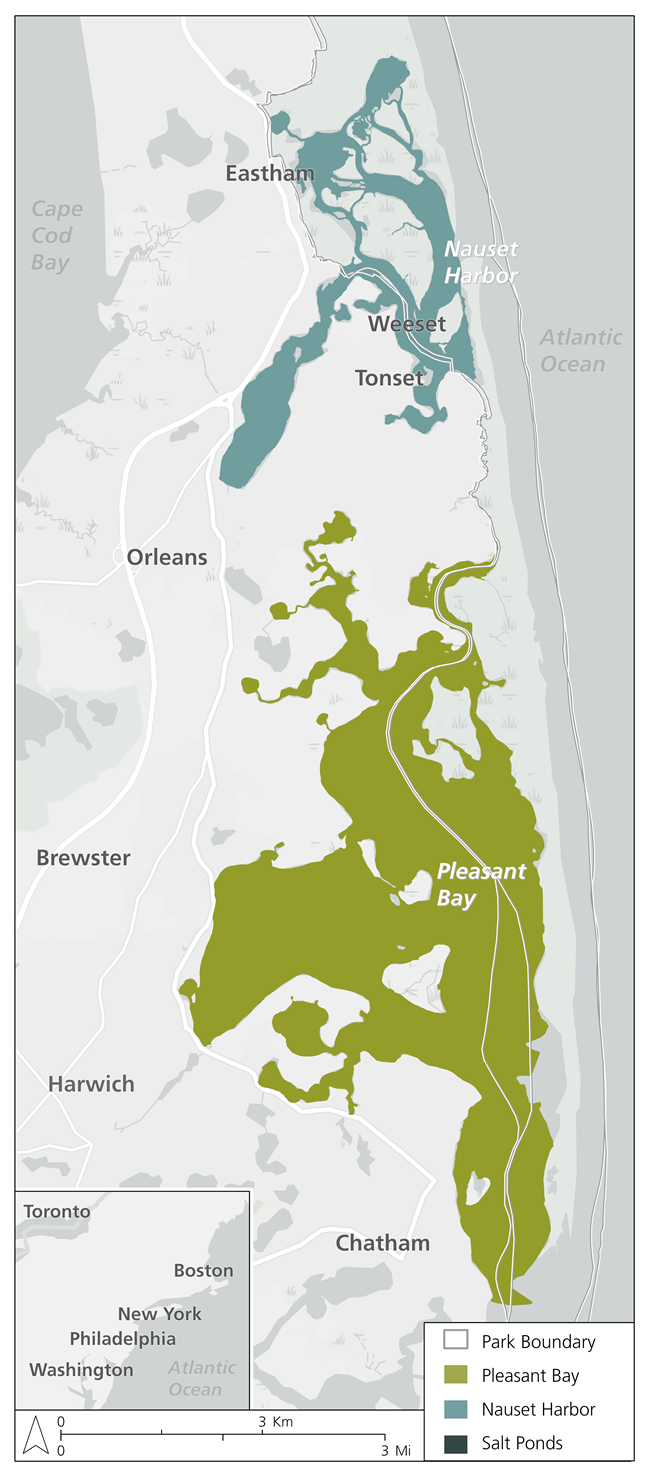
Site Context
Cape Cod is a large glacial moraine peninsula that extends 96.5 km into the Atlantic Ocean from the coast of Massachusetts. Cape Cod National Seashore (CACO) is located on the outer portion of Cape Cod (Fig. 1). Almost all the estuarine habitat at CACO is associated with two large coastal lagoon systems, Pleasant Bay (PB) and Nauset Harbor/Marsh (NH). Due to restricted flushing with the ocean and residential development pressures outside the seashore boundary, the National Park Service (NPS) interest in estuarine condition extends throughout these coastal embayments, not just in the areas within the seashore boundary. Pleasant Bay and Nauset Harbor are each fringed by small, deep, glacially-formed kettle-hole salt ponds that flush with seawater from the lagoons. Because deep water replacement may be restricted through density stratification, and the presence of shallow sills at their mouths, these estuarine kettle-holes are particularly susceptible to over-enrichment.
The threat of nutrient enrichment is a primary management concern. Water quality monitoring follows Northeast Coastal and Barrier Network’s Protocol for Monitoring Estuarine Nutrient Enrichment (Kopp and Neckles, 2009). The protocol’s primary goal is to assess how estuarine natural resources are affected by changing nutrient inputs by determining the status and trends of response indicators within the monitored estuarine areas of each park.Presented here are condition status summaries of three key response indicators:
1) bottom water dissolved oxygen (DO)
2) surface water chlorophyll-a
3) water column light attenuation (Kd)
The condition of these indicators is presented for the entire monitored area, providing a parkwide condition across all strata and for each individual stratum (Fig. 1):
1) Pleasant Bay (PB)
2) Nauset Harbor (NH)
3) salt ponds (SP)
Threshold values are used to determine “good”, “fair”, and “poor” condition categories (Table 1), which are consistent with those used by the US Environmental Protection Agency (USEPA) for national coastal condition reporting (USEPA 2001b, 2004) and thresholds used by National Oceanic and Atmospheric Association for the National Estuarine Eutrophication Assessment (Bricker et al. 1999).
Water clarity is expressed as Kd (m-1). Cutoff values of Kd have been calculated from the USEPA criteria for turbidity, using the thresholds for areas with significant submerged aquatic vegetation (SAV).
| Measure | Good | Fair | Poor |
|---|---|---|---|
| Chlorophyll-a | < 5 µg/L | 5-20 µg/L | > 20 µg/L |
| Dissolved oxygen | > 5 mg/L | 2-5 mg/L | < 2 mg/L |
| Light attenuation | < 0.92 m-1 | 0.92-1.61 m-1 | > 1.61 m-1 |
Bottom Water Dissolved Oxygen
Bottom water DO concentration is an indirect indicator of nutrient load and direct indicator of estuarine water chemistry and organism health. Oxygen is consumed when microbial decomposers mineralize organic matter on and within estuarine sediments. When sediment organic matter increases due to nutrient over-enrichment it can cause an overgrowth of nuisance algae. The resulting heightened microbial decomposition can lower DO concentrations in bottom waters. It can also lead to increased extent and duration of bottom water anoxia and toxic sulfide concentrations. Nutrient enrichment can, ultimately, impact fauna diversity and abundance and shift species dominance.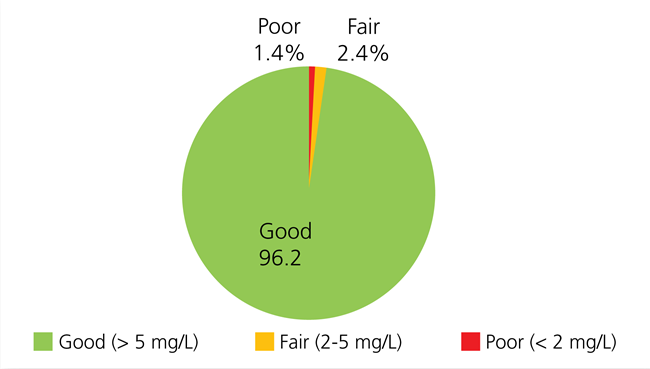
Park-wide
During the 2021 summer index period, CACO park-wide average bottom water dissolved oxygen concentrations were good within 96.1% of the total sampled estuarine area, fair within 2.4% and 1.4% was poor (Fig. 2).
Pleasant Bay
Average bottom water DO concentration was good within 99.5% of the PB stratum (Fig. 3). The remaining 0.5% had fair DO. 2021 conditions were consistent with previous index periods, with the exception of 2007-2009 and 2011, when a slightly larger portion of the estuary fell within the fair threshold.
Nauset Harbor
Average bottom water DO concentration was good within 89.2% and fair within 6.3% of the NH stratum (Fig. 3). The remaining 4.6% had poor DO. 2021 conditions were consistent with previous index periods when most of the estuary had good bottom water DO concentration, however, 2021 marked the third consecutive year in which DO was poor in some portion of the estuary.
Salt Ponds
Average bottom water DO concentration was good within 67.4% and fair within 19.7% of the SP stratum (Fig. 3). The remaining 12.9% had poor DO. 2021 conditions were consistent with previous index periods.
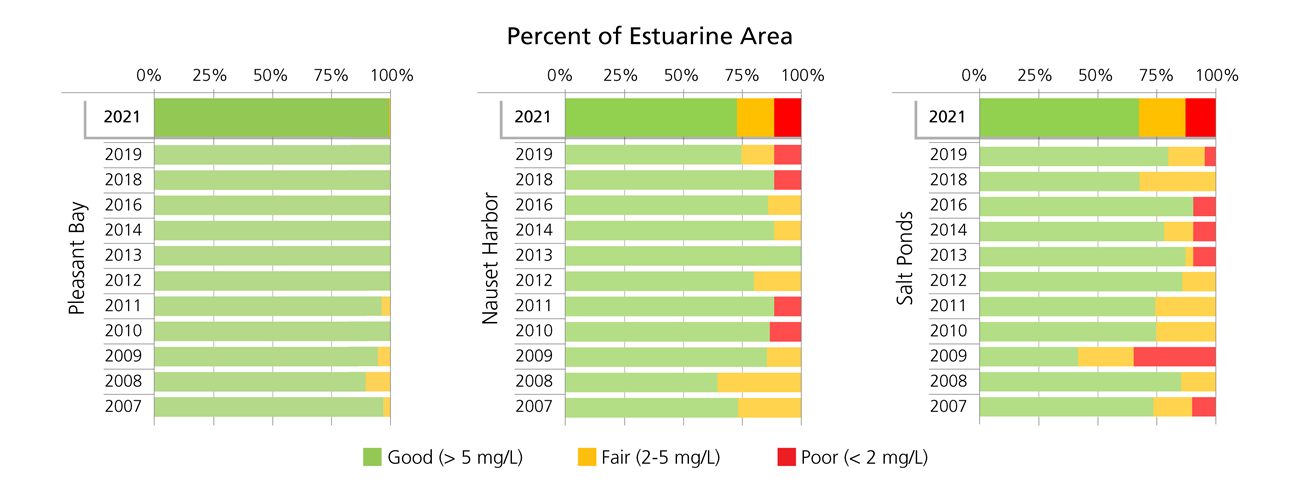
Surface Water Chlorophyll-a
Nutrient enrichment often stimulates phytoplankton production, leading to population growth. Phytoplankton growth is often nutrient-limited. Trends of increasing biomass can suggest increasing nutrient load. Surface water chlorophyll-a concentration is an indicator of phytoplankton population growth, nutrient enrichment, and overall water quality.

Pleasant Bay
Average surface water chlorophyll-a concentration was good within 99.9% of the PB stratum, and 0.1% of the estuary was in fair condition (Fig. 5). 2021 marked the first index period in which virtually no portion of the PB stratum had less than good surface water chlorophyll-a conditions.Nauset Harbor
Average surface water chlorophyll-a concentration was good within 80.4% of the NH stratum, and fair within 19.6% (Fig. 5). The 2021 index period marked the first time in which surface water chlorophyll-a conditions were food in more than 70% of the estuary.Salt Ponds
Average surface water chlorophyll-a concentration was good within 66.0% of the SP stratum, fair within 30.7%, and poor within 3.3% (Fig. 4). The 2021 index period marked the first index period in which surface water chlorophyll-a conditions were good in most of the SP stratum.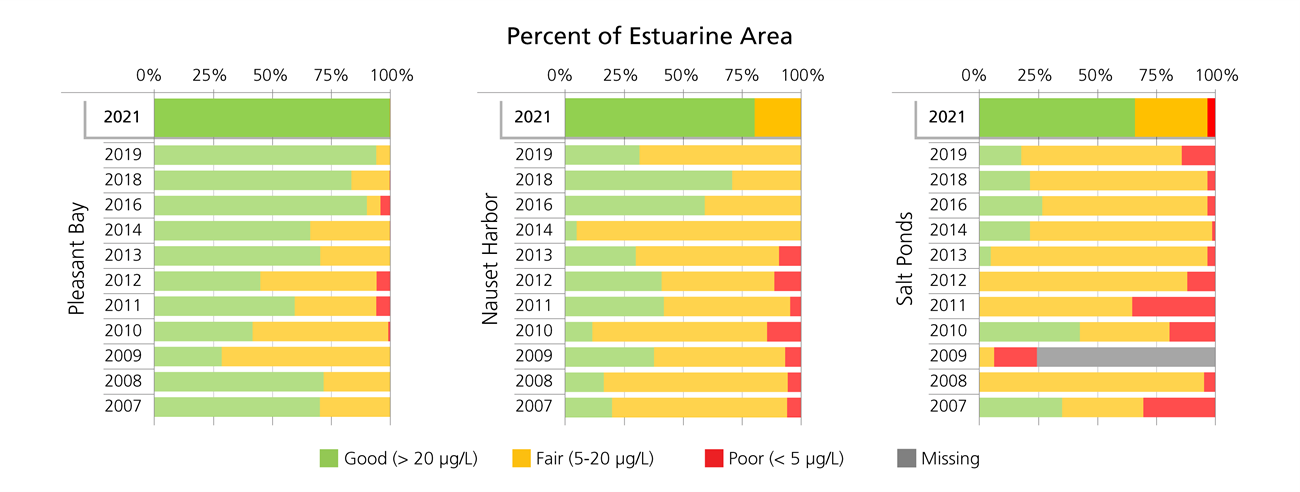
Water Column Light Attenuation
Submerged aquatic vegetation (SAV) provide important ecosystem services. The seagrass, eelgrass (Zostera marina) is the primary SAV species in NH and PB. Eelgrass productivity and distribution depend on light. Light attenuation through the water column is influenced by concentrations of phytoplankton, which can correlate with nutrient enrichment, and suspended inorganic and dissolved organic matter. This critical seagrass parameter also provides information relevant to the overall estuarine eutrophication status.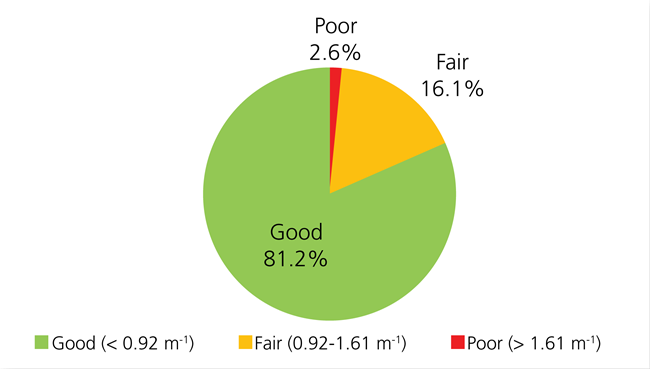
Park-wide
During the 2021 summer index period, CACO park-wide average water column light attenuation Kd (m-1), was good within 81.2% of the total sampled estuarine area, fair within 16.1%, and poor within 2.6% (Fig. 6).Pleasant Bay
Average water column light attenuation was good within 86.1% of the PB stratum, and fair within 13.9% (Fig. 7). 2021 conditions were consistent with all previous index periods since 2012, with most of the estuarine area in good condition, and only a small area with poor light attenuation, if any. During the 2007 through 2011 index periods, some portion of the estuarine area had poor light attenuation or was missing data.Nauset Harbor
Average water column light attenuation was good within 65.0% of the NH stratum, and fair within 20.0% (Fig. 7). The remaining 15.0% was poor. 2021 conditions were somewhat improved from previous index periods, with most of the estuarine area in good condition, however, with an increase in the proportion of the sampled area with poor light condition.Salt Ponds
Average water column light attenuation was good within 61.5% of the SP stratum, and fair within 38.5% (Fig. 7). 2021 conditions were consistent with previous index periods, with a slight decline since 2018. 2021 is one of only four index periods when there was no proportion of the monitored estuarine area in poor condition.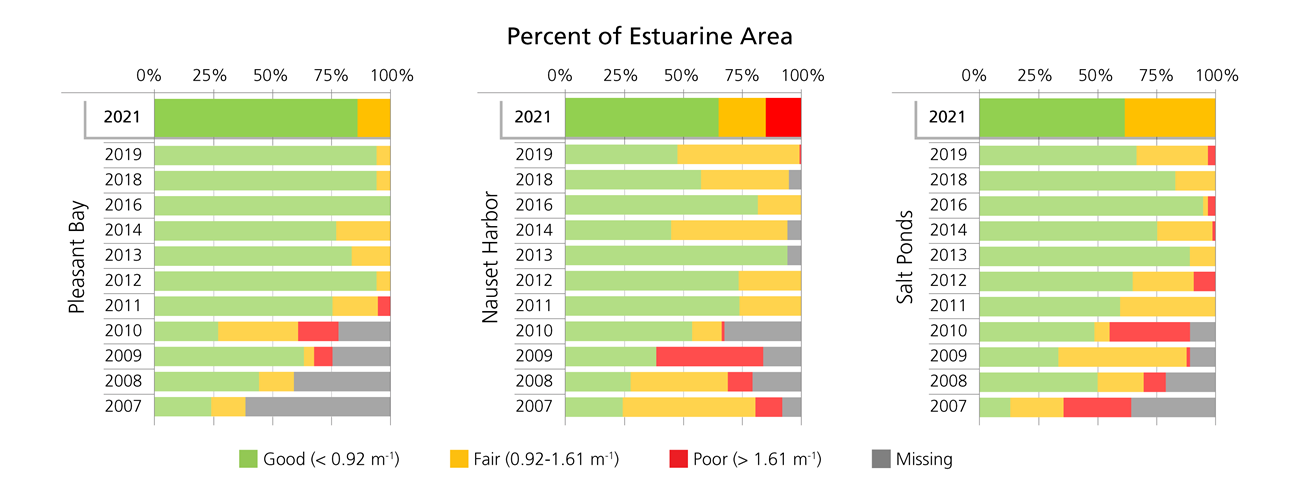
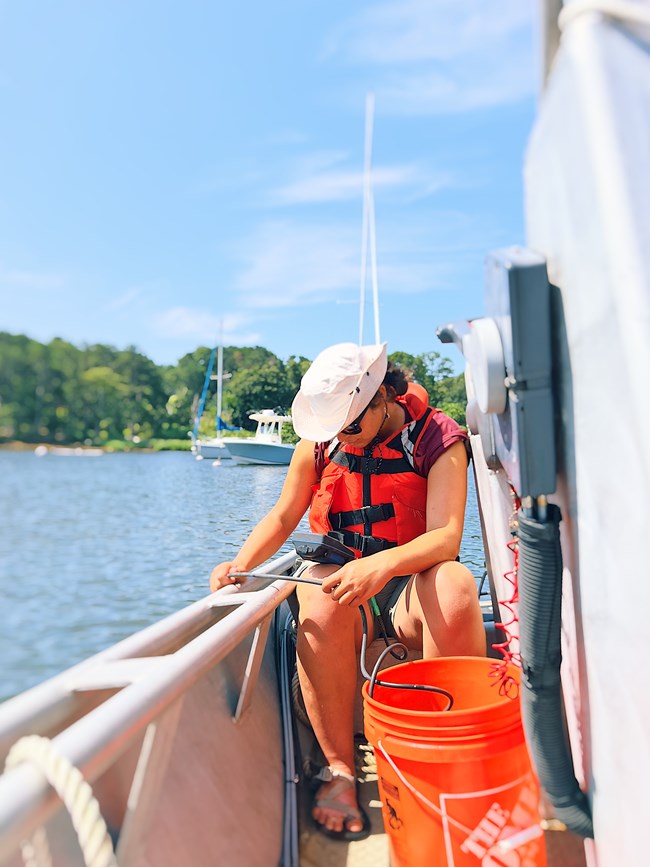
NPS Photo / Michaela Compo
Conclusion
In 2021, Cape Cod National Seashore saw varying conditions of bottom water dissolved oxygen, surface water chlorophyll-a, and water column light attenuation (Kd) throughout Pleasant Bay, Nauset Harbor, and salt ponds strata.The majority of sampled estuarine area for bottom water dissolved oxygen concentration was in good condition for all strata. Poor conditions were observed only in Nauset Harbor and the salt ponds. Historically, bottom water dissolved oxygen levels have been good for most of the estuarine area in the CACO sample system. In terms of surface water chlorophyll-a, the majority of the area of all strata was in good condition, with a lesser majority percentage in Nauset Harbor and salt ponds strata. Nauset Harbor and salt ponds had similar conditions in 2021. Water column light attenuation conditions were good throughout the majority of the sampled estuarine area in all strata. Nauset Harbor and salt ponds contained a lesser majority percentage of good condition than Pleasant Bay, with NH also having a proportion of the stratum in poor condition.
Conditions of these three status indicators at Cape Cod National Seashore in 2021 indicate that the estuarine systems are experiencing varying degrees of nutrient over-enrichment and water quality varies considerably among the strata.
References
Kopp, B. S. and H.A. Neckles. 2009. A Protocol for Monitoring Estuarine Nutrient Enrichment in Coastal Parks of the National Park Service Northeast Region. Natural Resource Report NPS/NCBN/NRR—2009/110. National Park Service, Fort Collins, Colorado.
U.S. EPA. 2001. National coastal assessment: field operations manual. U.S. Environmental Protection Agency, Office of Research and Development, National Health and Environmental Effects Research Laboratory, Gulf Ecology Division, Gulf Breeze, FL. EPA 620/R-01/003.
U.S. EPA: 2003. Ambient Water Quality Criteria for Dissolved Oxygen, Water Clarity and Chlorophyll a for the Chesapeake Bay and Its Tidal Tributaries, EPA-903/R-03/002, United States Environmental Protection Agency, Region III Chesapeake Bay Program Office, Annapolis, MD; Region III Water Protection Div., Philadelphia, PA, and Office Water, Office of Science and Technology, Washington, D.C.
Last updated: April 8, 2025
